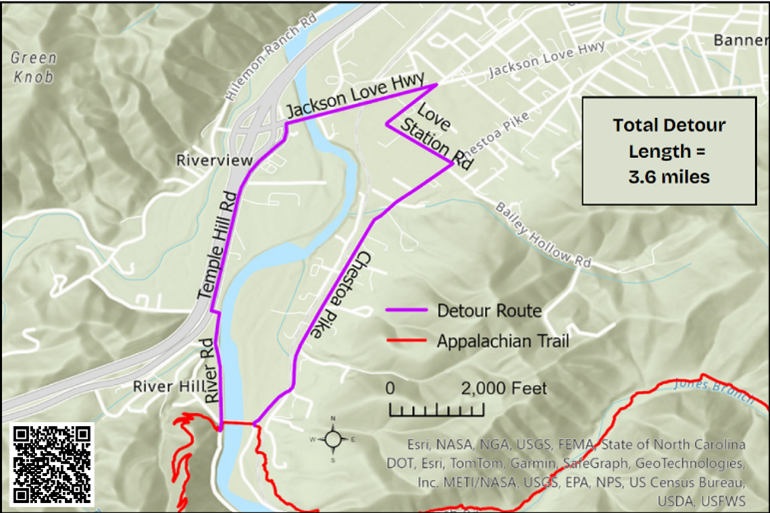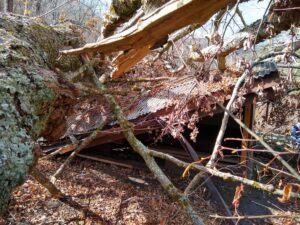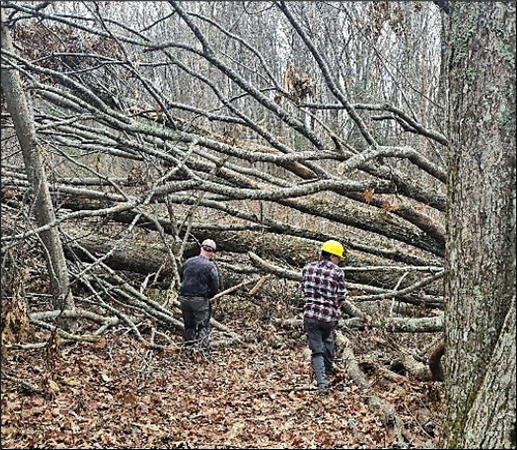Per club records from October 2024 through March 2025, trip reports for hurricane recovery activities (versus normal maintenance) has now made the 134 miles managed by TEHCC passable (with temporary detours). A total of 190 events tallied 8,043 volunteer hours (plus US Forest Service) involving 867 hours with chainsaws. Work is expected to continue throughout the Summer to widen the passageway, repair shelters, and remediate rootball damage.
Appalachian Trail – Hurricane Helene Recovery Update
Current Status:
Closure notice for the Appalachian Trail (link to Forest Order# 08-11-08-25-01) designated within the Appalachian Ranger District (ARD) of the Pisgah National Forest (PNF, North Carolina) continues (last updated 3/14/2025) to remain officially closed from Indian Grave to to Hughes Gap (AT NOBO mileage 352.9 to 374.2). However, a detour (link) has been established around Iron Mountain Gap (NOBO mileage 360.6 to 365.9) which is marked with temporary plastic white blazes and maps at each end. The bypassed section is blocked with excessive downed timber slated for removal this summer, thus hikers are not to be in this closed areas due to its hazards.
A new PNF/ARD Forest Order No. 08-11-08-25-02 (not yet publically posted at the time this update was written) prohibits campfires within the Roan Mountain area (Hughes Gap to Doll Flats). Camp stoves are allowed if the area is barren or cleared of all overhead and surrounding flammable materials within three feet. It is effective until 9/8/2025 unless lifted earlier. Enforcement will begin with a fire prevention tech talking to folks up in this high use spots within the closure area. Everyone should emphasize that campfires are not be used through any Helene damaged areas.
New: A no-charge ferry service has been established by the Appalachian Trail Conservancy (ATC) for hikers across the Nolichucky River at the Chestoa Pike bridge which was washed away by Hurricane Helene. (Link) It will operate between 9am to 2pm from March 17th to June 15th, unless inclement weather conditions pause the service. Hikers are required to sign a release form, wear a life jacket, and follow instructions. Alternative is an official 3.6 mile road walk detour. Please be careful as the roads are not hiker-friendly, missing sidewalks with vehicle traffic on some sections. The plan to replace the bridge has been announced, thus is in the early design phase.
The Moreland Gap Shelter is open. The metal roof has been covered with a heavy tarp, but could leak in a heavy rain. Long-term plans will be discussed for the shelter
Continuing Efforts:
While the A.T. is “Open”, it does not mean it is completely safe or cleared to all locations. Dead trees will continue fall. Please watch out for hazard trees at bridges, shelters, campsites, and water sources; reporting any to the club and/or forest service to give priority for removal. The focus is transitioning from punching through the primary path to the subsequent priorities of removing blowdowns from key campsites, around shelters, and on blue blaze trails to water. The club will also be repairing the deep holes in the tread caused by the many root balls pulled out of the ground.
The Southern Appalachian Wilderness Stewards (SAWS) have provided a path through the Pond Mountain Wilderness (between Dennis Cove Road and US321) and Big Laurel Branch Wilderness (containing Vandeventer shelter).
While the trail club continues regular weekly crews with some weekend trips, the weather forecast will impact the actual workdays and locations. Bad weather has delayed twice a joint effort with the Elizabethton High School Mountain Club. At the meeting location (frequently the Roan Mountain Community Park), volunteers will be divided into small groups for the assignments. Third Saturday trail maintenance is also being done at Bays Mountain Park in Kingsport.
Appalachian Trail – Hurricane Helene Recovery Update
Current Status:
Closure notice for the Appalachian Trail (link to Forest Order# 08-11-08-25-01) designated within the Appalachian Ranger District (ARD) of the Pisgah National Forest (PNF, North Carolina) continues to remain officially closed from Indian Grave to to Hughes Gap (AT NOBO mileage 352.9 to 374.2). While the Tennessee Eastman Hiking & Canoing Club (TEHCC) is making progress on clearing a path through this section, excessive downed timber is slated for removal north and south of Iron Mountain Gap, thus hikers are not to be in those areas for safety purposes. A shuttle will be required if the temporary bypass is not in place. Warning signs will be in displayed during the actual removal effort with potential enforcement action for who do not heed.
An official 3.6 mile road walk detour (refer to the separate article in this newsletter) has been established around the destroyed Chestoa Pike Bridge over Nolichucky River. It is now part of the Appalachian Trail until the bridge is replaced. FEMA announced in early February $9.77M funding to replace the bridge (link). Please be careful as the roads are not hiker-friendly, missing sidewalks with vehicle traffic on some sections.
While most of the A.T. is “Open”, it does not mean it is completely safe and/or cleared to all locations. The focus has been on the primary path, so blue blaze side trails to water sources may not be readily passable. Dead trees will continue fall. Please watch out for hazard trees at bridges, shelters, campsites, and water sources; reporting any to the club and/or forest service to give priority for removal.
Continuing Efforts:
Per the club records, during October to mid-February over 5,500 volunteer hours have been given to the recovery effort. We wish to thank the many volunteers, who are genuinely interested in participating, including experienced maintainers from other A.T. clubs and Johnson City Hiking Club. The focus remains opening the A.T. for section and thru hikers, while the subsequent priorities are to remove blowdowns from key campsites, around shelters, and on blue blaze trails to water. Please ensure at least 10-15 feet around a campfire ring is cleared as the dead brush and trees dry to become fire hazard. The club will also be repairing the deep holes in the tread caused by the many root balls pulled out of the ground; however, some work will be delayed until warmer Spring weather arrives.
Pond Mountain Wilderness between Dennis Cove Road and US321 is now open except for up on Pond Flats. In March, experienced crosscut sawyers will tackle opening what is needed for hikers. Southern Appalachian Wilderness Stewards (SAWS) will focus on the remaining five miles within Big Laurel Branch Wilderness (one mile south of the Vandeventer shelter to northern wilderness boundary).
While the trail club continues regular weekly crews with some weekend trips, the decision was made to limit event size until April due to the Winter weather. We are also guiding other groups (such as scouts) to stay off Appalachian Trail between Interstate 40 (easier reference) and Virginia but enjoy public lands to the west.
Official A.T. Detour for the Nolichucky River
The Chestoa Bridge was destroyed during Hurricane Helene. It was the Nolichucky River crossing for the Appalachian Trail. The USFS, TN DOT, and town of Erwin agreed to a 3.6 mile road walk detour until the bridge is rebuilt. It has been marked with white blazes as the official A.T. route temporarily.
The Appalachian Trail Conservancy is sharing these cautions:
- There is currently heavy truck traffic on Unaka Spring Rd/River Rd due to repairs to the railroad upstream. This is a narrow road with no shoulder.
- Walk on the left side of the road when possible, facing traffic.
- Wear bright colors and wear your headlamp with the light on, even during the day.
- Do not walk along roads at night.
- Walk single file; do not walk side by side
NOBO (northbound) Directions:
- Come out of the woods and turn left on Unaka Springs Rd/River Road and walk 0.5 mi to Temple Hill Rd/TN 36. You’ll walk right past Uncle Johnny’s Hostel.
- Turn right on Temple Hill Rd and follow for 0.8 mi to the Jackson Love Highway.
- Turn right on Jackson Love Highway and follow for 0.5 mi to Love Station Rd.
- Take the sharp right on Love Station Road/Carolina Ave and follow for 0.5 mi to Chestoa Pike.
- Turn right on Chestoa Pike and follow for 1.3 mi back to the other side of the washed out bridge. The A.T. heads back up into the woods to the left, off Jones Branch Rd just past the intersection.

TEHCC End of 2024 Update for Appalachian Trail/Hurricane Helene Recovery
Updates from late November post below.
- A.T. designated within North Carolina (Doll Flats south to just north of Iron Mtn Gap) remains CLOSED. Do not enter this stretch of trail.
- As of December 23rd, the Appalachian Trail is now clear and open from Iron Mtn Shelter to TN/VA border (444.8 mi NOBO to 467.3 mi per 2024 AT Data Book).
- However, trees will continue fall over the next year. Please watch out for hazard trees at bridges, shelters, campsites, and water sources; reporting any to the club and/or forest service to give priority for removal.
- Along the Elk River from Jones Branch (~399.2 mi NOBO) to Sugar Hollow (400.9 mi) is still severely damaged through erosion.
- Caution: Iron Mtn Gap to Unaka Mtn is really is impassible in any reasonable time.
- Repair of shelters at Moreland Gap (may remove damaged roofing) and Cherry Gap will likely not be pursued during 2025.
- Planned workdays during the winter will drop Tuesdays to continue on Thursdays plus 2nd and 4th Saturdays, with adjustments for weather announced at the start of each week.
- USFS fire fighters did not get to work in December as they had to perform their primary role (fight fires) elsewhere.
- Three weeks of Konnarock Crew is being scheduled for March-April, with option for another three weeks at the end of the work season in July-August
As of December 31, 2024, our club maintenance reports indicated that 57.3 miles or 43% of our 134 designated miles have been cleared. Volunteers contributed 4,054 hours across 87 outings, including 554 hours by chainsaw sawyers.
Hurricane Helene Recovery for the Appalachian Trail
Current Status:
All sections of the Appalachian Trail within the Pisgah National Forest (North Carolina) officially remain closed, specifically TEHCC Maintenance Sections 14a-16b from Doll Flats to just north of Iron Mountain Gap.
While the A.T. is shown as “Open” for Cherokee National Forest (Tennessee), it does not mean it is safe and/or cleared for passage. Some sections yet to be reached are reported to take four to five hours just to travel two to three miles.
Moreland Gap Shelter is closed due to roof damage. Cherry Gap Shelter is smashed down to the sleeping platform.

Progress as of mid-November:
Club trip reports indicated that over 2,000 volunteer hours have been invested in 48 events to clear a basic path through 33 miles of the A.T. Sections that have been touched include: 2.3 miles north of Abingdon Gap Shelter to McQueens Gap, US421 to Iron Mtn Shelter, Wilbur Dam Road to 2.75 miles north, Bitter End to Elk River, Curley Maple Gap Shelter to the former Chestoa Pike bridge, Nolichucky River to Cliff Ridge, and just south of No Business Knob Shelter to Devils Creek Gap. Note that these are not continuous and with the difficult tangles left for professionals to resolve.
Near-term efforts:
Weather permitting (especially with winter approaching), crews of 4-10 members with multiple sawyers and swampers are being dispatched on Tuesdays, Thursdays, plus 2nd and 4th Saturdays to not wear out the volunteers. Sawyers must have current first aid training and certification by the US Forest Service. Typically 35-50 blowdowns are cut per day per crew with some filling in of holes caused by root balls torn out of the ground. Specific plans are not made until the week (or maybe two) prior. Volunteers are added to a distribution list, then reply when available (no need for regrets) to allow for right group size and equipment. Inquiries have been received, including OH and VT.
The Appalachian Trail Conservancy is hiring a four-person professional saw crew (USFS fire fighters) for first two weeks of December to clean up some of the challenging damage.
Ongoing plans:
Four weeks of Konnarock Crew to be scheduled for 2025.
Volunteers from other A.T. clubs could be organized into crews, especially sawyers.
It is currently uncertain, especially with winter weather, if the entire A.T. path along NC/TN border will be opened when 2025 NOBO hikers begin to pass through the region, thus may recommend a partial “skip and return” hike.
Hurricane Helene Update (as of 10/22/2024)
All sections of the Appalachian Trail within the Pisgah National Forest (North Carolina) remain closed, specifically TEHCC Maintenance Sections 14a-16b from Doll Flats to just north of Iron Mountain Gap. North Carolina Dept. of Transportation asks the public to limit travel in Western North Carolina to essential traffic only.
Over the past three weeks, Cherokee National Forest staff, along with out-of-state crews, have been assessing the storm’s impact. On October 15, access to significant portions of the Appalachian Trail within the Cherokee National Forest was restored, though the area between US19E and US321 remains closed, specifically TEHCC Maintenance Sections 9a-12d from Shook Branch to east of Roan Mountain. The USFS warns that “portions of the Appalachian Trail remain closed or inaccessible with hundreds of trees per mile blocking the route”.
A few volunteer groups are now being organized by the club for work in Tennessee to obtain more details about access routes, trailheads, bridges, shelters, and tread damage – and perform minor maintenance activities with hand tools only. No individual should enter the forest alone.
As the situation on the ground evolves, more updates will be provided for the Appalachian Trail recovery efforts.
Roan High Knob shelter closed for repairs to be made in 2025
The Roan High Knob shelter is shifting on its foundation due to several rotting logs, thus is closed for safety reasons until extensive repairs can be made in 2025 which could take through October. The USFS closure notice also includes a 60-foot buffer for no camping around the shelter. Please stay away from the shelter which has its door bolted shut and first floor removed.
Camping is available at Ash Gap.
Forest Road 230 from Indian Grave Gap to Beauty Spot Overlook is now OPEN
USFS shares: UPDATE 8/19/2024 – Repairs to Beauty Spot Overlook are now complete. The overlook is now open.


